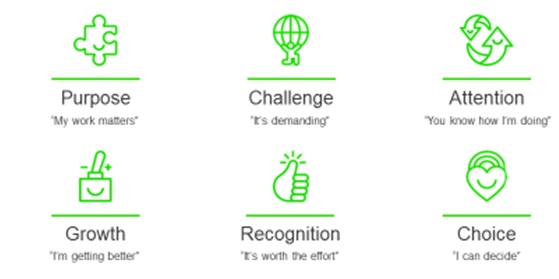W. Edwards Deming insisted that you improve performance by improving the system not blaming people.
He stated that the variation in employee performance (from their worst day at work to their best) was 5% down to the individual and 95% down to the conditions in the environment. And therefore managers should focus more attention on fixing problems in the system than ‘fixing people’.
The debate around how applicable this theory is to businesses today rages on, but what’s becoming clear is that the key to creating a high performance culture is setting up and maintaining the right psychological conditions.
Mind Gym’s psychologists have identified six ‘conditions’ which have significant impact on building an environment where we’re all performing at the top of our game.
The science doesn’t suggest that any one of these conditions has more impact than any other, but rather that the six conditions are like an ecosystem where the elements are all inter-related – when one is strengthened it automatically strengthens and supports the others.
Who’s responsible?
In the traditional world of performance management, primary responsibility lies with the line manager and HR is chief enforcer of the process.
In the new world of focusing on the right conditions for high performance, the employee plays a far more active part.
Manager and employee both have a role to play and they can succeed only by acting in unison. This gives employees much greater licence to influence their chances of success, while managers are prompted to focus on setting their team members up to succeed.
The buck cannot be passed. We really are in this together.
So what are these six conditions that give people the best chance of performing at the top of their game?

1. Purpose: My work matters
Why am I doing this? It’s a question most of us have asked ourselves. The richer our answer the more likely we are to perform at the top of our game. There are three types of ‘purpose’ that directly affect performance:
- Task purpose. Knowing our work counts and isn’t futile.
- Collective purpose. Seeing how our work combines with others’ to create something none of us could achieve alone.
- Social purpose. Recognising that our work makes a worthwhile contribution beyond the success of our organisation.
Whether we work in the back office of a bank or the front line of a charity, we can derive purpose from a task well done, by achieving goals as part of a team, and by paying attention to our social impact.
2. Challenge: It’s demanding
We perform best when we’re suitably challenged. The question is: how much challenge is reasonable?
There’s much more to challenge than simply setting goals and measuring performance. The most performance-enhancing goals are:
- Just out of reach. If you believe your goal is just about possible but can’t currently see how you’d achieve it, it’s probably the right level of stretch.
- Aligned. Individual goals that are aligned to strengths, motivations as well as the organisational strategy.
- Always up for review. The world around us changes fast and so goals need refreshing too.
A 6-year study of 229 entrepreneur CEOs concluded that business growth was largely driven not just by stretching goals but by helping employees believe they could achieve them. In building this belief, the manager’s responsibility is to help the individual appreciate the goal is ‘just about possible’. The individual’s responsibility is to take on the challenge.
3. Attention: You know how I’m doing
The feedback that makes the biggest difference is:
- Descriptive. Saying what you see someone do has more impact than evaluating it.
- Informal. Comments given frequently as part of conversations are easier to digest and allow time for reflection.
- Informed. Managers have awareness of what everyone is doing.
The simple act of noticing and saying what you noticed can be the most powerful feedback. Employees who think their manager always knows what they’re up to and how they’re doing, are far more likely to feel appreciated and raise their game.
The key to paying attention is lightly and often. A quick observation, delivered informally can have more impact than a formal conversation. Frequent feedback is best, at the very least once every two weeks.
4. Growth: I am getting better
We grow faster when we have:
- A growth mind-set – believing we can get better.
- A role that plays to our strengths and skills.
- Sight of better prospects. We can see that by getting better now, we’re more likely to attain something that matters to us in the future.
Those who cannot see how their working life can progress get stuck. They have lowered aspirations, diminished self-esteem, are less engaged, perform worse and are ultimately more likely to leave.
When promotions and pay rises are scarce, ‘moving’ needs to mean more than moving up the hierarchy. Progress may include new skills, project opportunities, lateral moves, job rotations, secondments, shadowing, leadership opportunities or even a sabbatical outside the company, all of which help people ‘unstick’ and get moving.
5. Recognition: It’s worth the effort
We feel most appreciated when recognition is:
- Fair. Based on clear criteria and applied consistently across the business.
- About me. Not the person giving it.
- Differentiated. The difference between how the best and worst are recognised is proportionate and based on objective, performance-related criteria.
One of the largest predictors of satisfaction is social comparison: employees who look around them and perceive they aren’t being recognised fairly don’t perform as well.
And so, though we might tell ourselves that the question which matters is: ‘is it worth the effort?’ we’re actually more affected by the answer to: ‘am I being treated fairly?’
Recognition done well delivers a significant boost in performance. In service organisations this can be by as much as 15%, rising to 30% when combined with feedback.
6. Choice: I can decide
We keep performance high when we:
- Create support networks. Building a strong network of technical, emotional and practical support.
- Adopt an optimistic outlook. Interpreting challenges as short-term, specific and insightful.
- Focus on what’s in our control. Drawing on inner strength and grit to maintain effort and interest over time to sustain performance in spite of setbacks.
You can’t always choose your circumstances but you can choose how you think about them and what you do as a result. This is the premise for the condition of ‘choice’.
Together with leaders, managers can reflect on where it’s possible to give people autonomy and ownership to maximise their choices. When discussing plans they should explain the choices people have in how to implement them and be open – sharing mistakes, risks, successes, challenges, opportunities and failing fast positively.
So put aside the discussions about rankings, annual reviews and flashy new HR software, because creating the right conditions for everyone to perform at the top of their game is the performance management approach of the future. And key to it is understanding the psychology of human behaviour.






